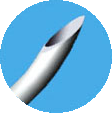Equipment
Before you start...make sure you know where to fing the resuscitation trolley and airway equipment. Hopefully you won't need them.
Ensure the patient has intravenous access and fluid is running.
Introduce yourself to your assisstant. Knowing their name is really useful.
You will need:
Sterile gown, gloves and mask.
Check that the hand wash is chlorhexidine or iodine containing and that it is designed for scubbing.
Antiseptic Solution
Alcohol and chlohexidine is recommended. Be sure to keep it away from the epidural needle and catheter since it is neurotoxic.
Epidural Kit
You will have a choice of brands but basically they are all Tuohy needles. The curved tip reduces the risk of spearing the dura but unfortunately does not eliminate it.
You will have a choice of size 18G or 16G. Pick one and use it until you get used to it.
The regular needle is 8cm long and marked at 1 cm intervals. It is nearly always long enough. There is a long needle available.
The Loss of Resistance syringe is purpose built. Don't subsitute a regular syringe!
The epidural catheter is 20G and has three holes in the last 1.5cm. It also has length markings.
The kit also has a 22 micron bacterial filter.
Other equipment
Sterile tray with sterile self adhesive drape.
23G needle and 1-2% lignocaine for skin anaesthesia
5ml syringe for skin local anaesthetic
10ml saline for "Loss of Resistance"
10-20ml - for epidural local anaesthetic bolus.
Local anaesthetic for bolus
Adjuvants drugs


